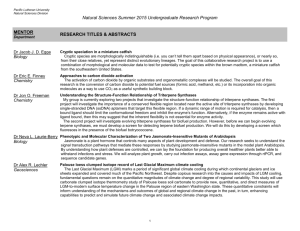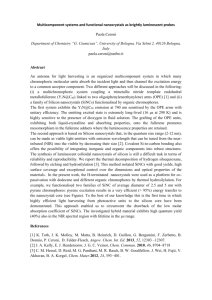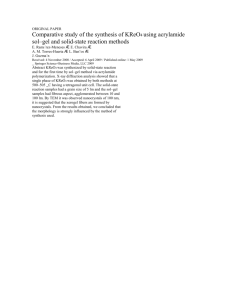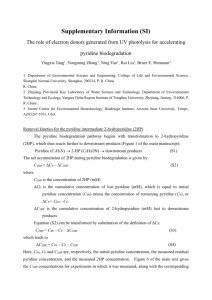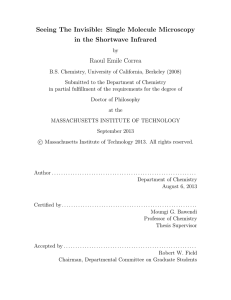Supplementary Informations
advertisement
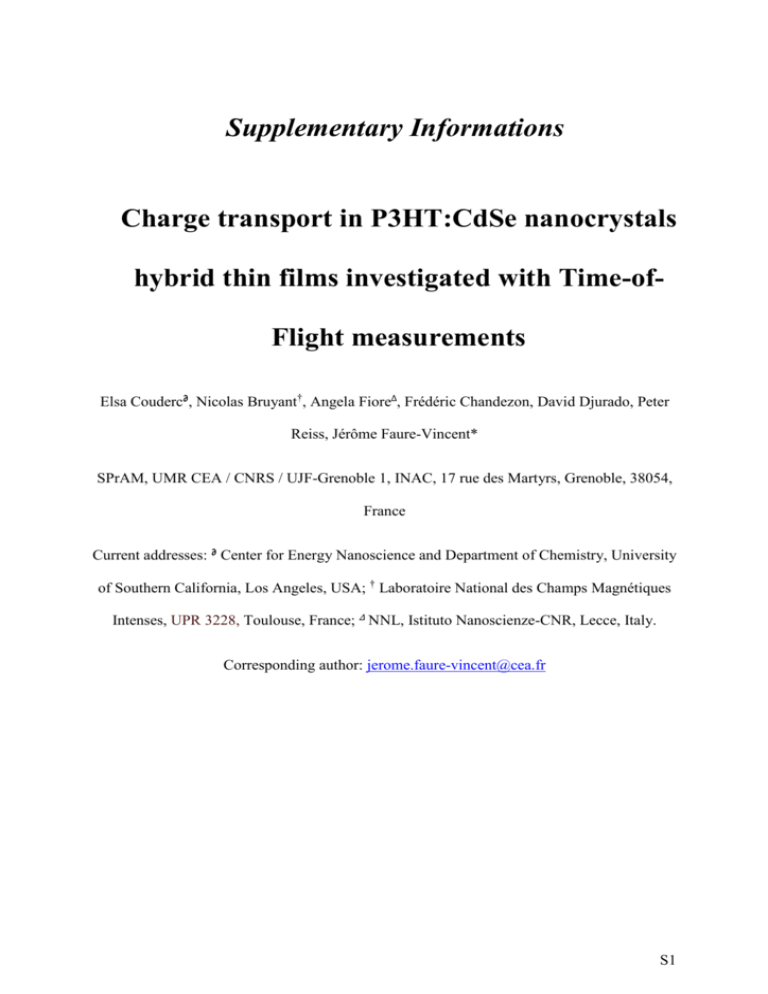
S Supplementary Informations Charge transport in P3HT:CdSe nanocrystals hybrid thin films investigated with Time-ofFlight measurements Elsa Couderc∂, Nicolas Bruyant†, Angela Fiore∆, Frédéric Chandezon, David Djurado, Peter Reiss, Jérôme Faure-Vincent* SPrAM, UMR CEA / CNRS / UJF-Grenoble 1, INAC, 17 rue des Martyrs, Grenoble, 38054, France Current addresses: ∂ Center for Energy Nanoscience and Department of Chemistry, University of Southern California, Los Angeles, USA; † Laboratoire National des Champs Magnétiques Intenses, UPR 3228, Toulouse, France; ∆ NNL, Istituto Nanoscienze-CNR, Lecce, Italy. Corresponding author: jerome.faure-vincent@cea.fr S1 Gram-scale nanocrystal synthesis. The synthesis of spherical CdSe nanocrystals follows the protocol described in Ref. S1 . For the gram-scale synthesis of branched CdSe nanostructures, 200 mL of trioctylphosphine-selenide (TOP-Se) at 0.4 M are rapidly injected in a mixture containing 8 mmol of CdSt2, 184 mmol of stearic acid, 280 mL of oleylamine and 186 mL of octadecene, heated to 230°C under argon atmosphere and vigorously stirred. When the temperature of the mixture has reached 230°C again, the reaction is left to take place for 18 minutes. The obtained nanocrystals are bipods, tripods and tetrapods. Purification is carried out by repeated precipitation and centrifugation as described in Ref. S1. Nanocrystals for TOF samples are redispersed in ODCB. Alternatively, ligand exchange with pyridine is performed by heating the nanocrystal dispersion in CHCl3 with an excess of pyridine to 110°C under argon atmosphere for 24 hrs. Nanocrystals are recovered by precipitation in hexane at 60°C and redispersed in pure pyridine for storage or in a pyridine:ODCB mixture (1:9 vol:vol) for hybrid preparation. Thin film deposition. Hybrid solutions are prepared by blending equal volumes of P3HT (fractionated following Ref. S2 and using the chloroform fraction) solution at 5 mg/mL in ODCB with the nanocrystal dispersion at the adequate concentration to obtain the desired weight ratio. For easier comparison with different types of heterojunctions, we also indicate the corresponding volume ratio. Around 200 mL of the hybrid solution was drop cast onto a clean, wet-etched ITO substrate and left to evaporate under solvent saturated atmosphere for around one week. This resulted in film thicknesses around 5-6 m (standard deviation 1-7%). Crystalline structure of hybrid thin films depending on the ligands of nanocrystals. GIXRD profiles of hybrid films measured by Time-of-Flight are presented on SI Figure 1. In the region between 20° and 35°, periodicities arising from the CdSe lattice and P3HT -stacking S2 overlap. The signals can nonetheless be deconvoluted in different peaks: 1) the (100), (002) and (101) peaks, characteristic of wurtzite CdSe, located respectively at 27.8°, 29.5° and 31.6°; and 2) the signal arising from P3HT -stacking around 26°. In the case of hybrids containing nanocrystals with their synthesis ligands, no signal from P3HT can be detected. On the other hand, when pyridine is present in the blend, a peak around 26° is necessary to achieve satisfactory fits of the GIXRD profiles, showing a better stacking quality in the presence of pyridine. SI Figure 1: GIXRD profiles of hybrid films used in TOF, made with branched nanocrystals a) treated with pyridine; b) capped with synthesis ligands. Typical transients measured in hybrid samples. Typical transients measured in hybrid samples are presented in SI Figure 2 for both electrons and holes at various applied voltages. S3 SI Figure 2: TOF transients measured in an hybrid sample containing 75 wt% of spherical nanocrystals capped with synthesis ligands on a log-log representation, for various applied voltages. Traces are shifted vertically for clarity. References S1 M. Protière, N. Nerambourg, O. Renard, and P. Reiss, Nanoscale Research Letters 6, 472 (2011). S2 M. Trznadel, A. Pron, and M. Zagorska, Synthetic Metals 101, 118 (1999). S4

